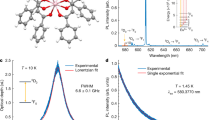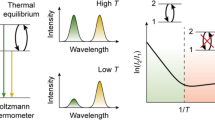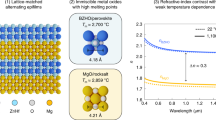Abstract
Rare-earth oxide materials emit thermal radiation in a narrow spectral region, and can be used for a variety of different high-temperature applications, such as the generation of electricity by thermophotovoltaic conversion of thermal radiation. However, because a detailed understanding of the mechanism of selective emission from rare-earth atoms has so far been missing, attempts to engineer selective emitters have relied mainly on empirical approaches. In this work, we present a new quantum thermodynamic model to describe the mechanisms of thermal pumping and radiative de-excitation in rare-earth oxide materials. By evaluating the effects of the local crystal-field symmetry around a rare-earth ion, this model clearly explains how and why only some of the room-temperature absorption peaks give rise to highly efficient emission bands at high temperature (1,000–1,500 °C). High-temperature emissivity measurements along with photoluminescence and cathodoluminescence results confirm the predictions of the theory.
This is a preview of subscription content, access via your institution
Access options
Subscribe to this journal
Receive 12 print issues and online access
$259.00 per year
only $21.58 per issue
Buy this article
- Purchase on Springer Link
- Instant access to full article PDF
Prices may be subject to local taxes which are calculated during checkout




Similar content being viewed by others
References
Chubb, D.L., Pal, A.M.T., Patton, M.O. & Jenkins, P. Rare earth doped high temperature ceramic selective emitters. J. Eur. Ceram. Soc. 19, 2551–2562 (1999).
Golovlev, V.V., Winston, C.H. & Garrett, W.R. Heat to light energy conversion by emitters doped with rare-earth metal ions. Appl. Phys. Lett. 69, 280–282 (1996).
Smentek, L. Theoretica description of the spectroscopic properties of rare earth ions in crystals. Phys. Rep. 297, 155–237 (1998).
Edmonds, A.R. Angular Momentum in Quantum Mechanics 68–79 (Princeton Univ. Press, Princeton, 1960).
Åberg, D., Edvardsson, S. & Engholm, M. Direct calculation of correlated absorption amplitudes for Nd:LiYF4 . Phys. Rev. B 68, 195105 (2003).
Lee, H.S., Farris, B., Filer, D.E. & Barnes, N.P. A computational study of host effects on Er3+ upconversion and self-quenching efficiency in ten garnets. Appl. Phys. 79, 573–577 (1996).
Reissland, J.A. The Physics of Phonons (Wiley, London, 1973).
Born, M. & Huang, K. Dynamical Theory of Crystal Lattice 7–98 (Oxford Univ. Press, 1954).
Madelung, E. Z. Physik 11, 898–905 (1910).
Slater, J.C. Atomic radii in crystals. J. Chem. Phys. 39, 3199–3200 (1964).
Clementi, E., Raimondi, D.L. & Reinhardt, W.P. Atomic screening constants from S.C.F. functions. J. Chem. Phys. 38, 2686–2687 (1963).
Licciulli, A. et al. The challenge of high performance selective emitters for TPV applications, Semicond. Sci. Technol. 18 (Thermophotovoltaic Special Issue), 174–183 (2003).
Licciulli, A. et al. Sol-gel preparation of selective emitters for thermophotovoltaic conversion, J. Sol-Gel Sci. Technol. 26, 1119–1123 (2003).
Diso, D. et al. in Proc. TPV5 The Fifth Conference on Thermophotovoltaic Generation of Electricity Vol. 653 (eds Coutts, T. J., Guazzoni, G. & Luther, J.) 132–135 (American Institute of Physics, Woodbury, New York, 2003).
Diso, D. et al. Erbium containing ceramic emitters for thermophotovoltaic energy conversion, Mater. Sci. Eng. B 98, 144–149 (2003).
Tundo, S. et al. in Proc. TPV5 The Fifth Conference on Thermophotovoltaic Generation of Electricity Vol. 653 (eds Coutts, T. J., Guazzoni, G. & Luther, J.) 201–209 (American Institute of Physics, Woodbury, New York, 2003).
Acknowledgements
We wish to thank Lorenzo Vasanelli for useful discussions. This work has been supported by the EC grant no. ERK6-CT-1999-00019 (project THE REV).
Author information
Authors and Affiliations
Corresponding author
Ethics declarations
Competing interests
The authors declare no competing financial interests.
Rights and permissions
About this article
Cite this article
Torsello, G., Lomascolo, M., Licciulli, A. et al. The origin of highly efficient selective emission in rare-earth oxides for thermophotovoltaic applications. Nature Mater 3, 632–637 (2004). https://doi.org/10.1038/nmat1197
Received:
Accepted:
Published:
Issue Date:
DOI: https://doi.org/10.1038/nmat1197
This article is cited by
-
Ruby Emission in the Range 400–800 nm with Excitation by Continuous-Wave CO2 Laser Pulses
Journal of Applied Spectroscopy (2017)
-
Thermally enhanced photoluminescence for heat harvesting in photovoltaics
Nature Communications (2016)
-
High-Efficiency Plasmonic Metamaterial Selective Emitter Based on an Optimized Spherical Core-Shell Nanostructure for Planar Solar Thermophotovoltaics
Plasmonics (2015)
-
Preparation and performance evaluation of Er2O3 coating-type selective emitter
Science China Technological Sciences (2014)
-
Application of micro/nanoscale thermal radiation to thermophotovoltaic system
Journal of Central South University of Technology (2011)



